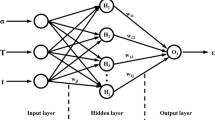Abstract
This article puts forward the results obtained when using a neural network as an alternative to classical methods (simulation and experimental testing) in the prediction of the behaviour of steel armours against high-speed impacts. In a first phase, a number of impact cases are randomly generated, varying the values of the parameters which define the impact problem (radius, length and velocity of the projectile; thickness of the protection). After simulation of each case using a finite element code, the above-mentioned parameters and the results of the simulation (residual velocity and residual mass of the projectile) are used as input and output data to train and validate a neural network. In addition, the number of training cases needed to arrive at a given predictive error is studied. The results are satisfactory, this alternative providing a highly recommended option for armour design tasks, due to its simplicity of handling, low computational cost and efficiency.










Similar content being viewed by others
References
Goldsmith W (1960) Impact. The theory and physical behaviour of colliding solids. Edward Arnold Publishers, London
Zaera R, Sánchez-Gálvez V. (1998) Analytical modelling of normal and oblique ballistic impact on ceramic/metal lightweight armours. Int J Impact Eng 21:133–48
Arias A, Zaera R, López-Puente J, Navarro C (2003) Numerical modeling of the impact behavior of new particulate-loaded composite materials. Comp Struct 61:151–59
Awerbuch A, Bodner SR (1974) Analysis of the mechanics of perforation of projectiles in metallic plates. Int J Solids Struct 10:671–684
Ravid M, Bodner SR (1983) Dynamic perforation of viscoplastic plates by rigid projectiles. Int J Eng Sci 21:577–591
Anderson CE (1987) An overview of the theory of hydrocodes. Int J Impact Eng 5:33–59
Minsky M, Papert S (1969) Perceptrons. MIT Press, Cambridge
ABAQUS/Explicit v6.4 User_s manual (2003) ABAQUS Inc., Richmond
Johnson GR, Cook WH (1983) A constitutive model and data for metals subjected to large strains, high strain rates, and temperatures. In: Proceedings of seventh international symposium ballistics, The Hague, The Netherlands, pp 1–7
Kirraine DE (1990) Machine learning, Training and Development. J 40:24–29
Rumelhart DE, McCleland JL (1986) Parallel distributed processing. MIT Press, Cambridge
Rumelhart DE, McCleland JL (1988) Parallel distributed processing VI: foundations. Bradford Books, New York
Hopfield JJ (1987) Neurons with graded response have collective computational properties like those of two state neurons. Proc Natl Acad Sci 81:4947–4960
Waszczyszyn Z, Ziemiański L (2001) Neural networks in mechanics of structures and materials—new results and prospects of applications. Comput Struct 79(22–25):2261–2276
Ince R (2004) Prediction of fracture parameters of concrete by artificial neural networks. Eng Fract Mech 71(15):2143–2159
Liu SW, Huang JH, Sung JC, Lee CC (2002) Detection of cracks using neural networks and computational mechanics. Comput Methods Appl Mech Eng 191(25–26):2831–2845
Tarassenko L (1998) A guide to neural computing applications. Arnold/NCAF, London
Acknowledgements
This research was done with the financial support of the Comunidad Autónoma de Madrid under Project GR/MAT/0507/2004.
Author information
Authors and Affiliations
Corresponding author
Rights and permissions
About this article
Cite this article
García-Crespo, A., Ruiz-Mezcua, B., Fernández-Fdz, D. et al. Prediction of the response under impact of steel armours using a multilayer perceptron. Neural Comput & Applic 16, 147–154 (2007). https://doi.org/10.1007/s00521-006-0050-1
Received:
Accepted:
Published:
Issue Date:
DOI: https://doi.org/10.1007/s00521-006-0050-1




